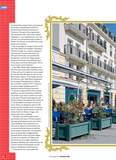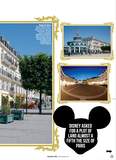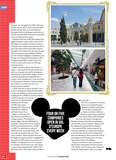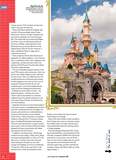When you think of Disney theme parks, roller coasters and cuddly characters come to mind. But, as Christian Sylt reports, the business model at the company’s outpost in Paris is also based on a far more mundane revenue stream: property.
TAKE A DRIVE 30KM TO the east of Paris and you’ll find a traditional French landscape: the sleepy villages with their cafés, boulodromes and boulangeries; rolling fields of beet. And then comes the new town of Val d’Europe... and you notice that something is different.
For starters, it is a vision of brightness: the buildings in the town centre have been designed in a classic 19th-century Parisian style, but are cream-coloured to make them look less gloomy in winter. To increase light at street level, the largest buildings are no taller than five storeys. The squares are smaller than those in other town centres so that passers-by don ’t Feel lost, and mothers have no trouble pushing their prams down the streets, because the pavements are extra wide.
These innovative touches are far from accidental. This is a new town designed by a company with a 60-year track record of creating the world’s most cutting-edge leisure developments: Walt Disney.
The American media giant isn’t renowned for pioneering real estate development, but in fact this has been at the heart of its theme park strategy for decades. The company ’s founder, Walt Disney, was so fascinated by town planning that he commissioned the construction of an experimental city in Florida that was due to have 20,000 residents, who would be Ferried around by monorails while road traffic was kept underground in order to protect pedestrians.
The plan died along with Disney himself in 1966 and instead the company built a science-based theme park in Florida known as EPCOT (Experimental Prototype Community of Tomorrow). Elements of the original plans were revisited in 1994, when Disney opened Celebration, a more traditional new town that sits next to its colossal theme park complex in Florida. Val d'Europe, on the other hand, arose almost out of necessity.
New towns began to emerge in France at the end of the 1960s at the instigation of president Charles de Gaulle, as a counter to haphazard urban growth. The entire area where Val d’Europe stands today was earmarked for development, with the five villages already sitting on the land set to be interlinked into it. Those plans were frozen following the I973 oil crisis, but they weren’t forgotten.
In the 1980s, Disney began negotiating with the French government about building a resort in Paris, and one of its objectives was to acquire far more land than the space on which its two theme parks would sit. This strategy stemmed from the time when Walt Disney bought land for his original Disneyland park in California and, soon after it opened in 1955, motels and restaurants began springing up next to it, spoiling the fantasy theming of the resort.
To prevent a repeat of this in France, Disney asked for a vast plot of land almost a fifth the size of Paris. It got what it wanted, but it came with a catch. The government agreed to sell the land to Disney provided that the majority of it was developed in accordance with its own vision. Disney was allocated a total of 2,230 hectares and the principle was for it to develop all of it. However, the government would only release the land to Disney in stages, once previous plots were completed.
[…]




